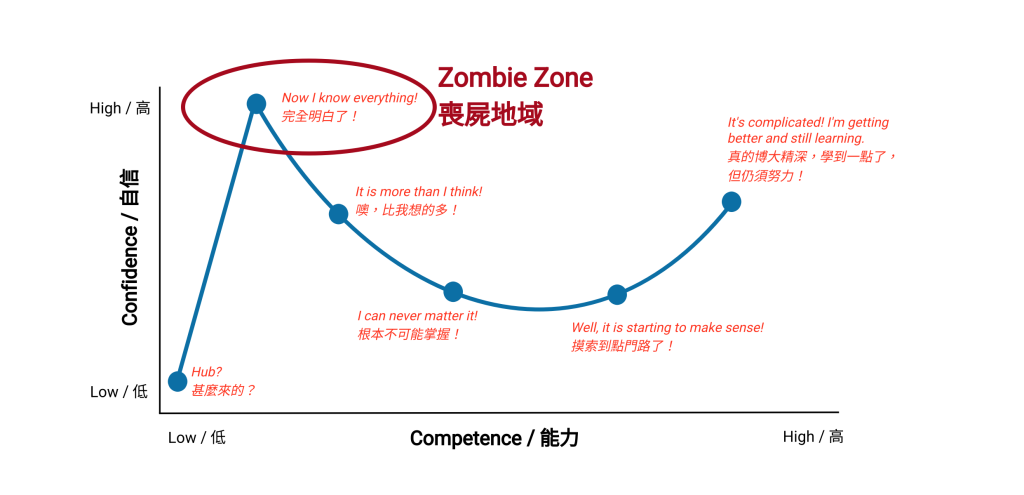Design Thinking is a good thing. It facilitates the business community toward more diversified and human-centered problem-solving. However, the rise of DT also brings the risks of people chasing the trend without really seriously learning the content.
I call these people Design Thinking Zombies, or DT Zombies for short. They are DT enthusiasts but stay at the stage of mere faith without really understanding the various concepts and methods.
To adopt the learning or enlightening cycle from Buddhism, you need to go through the path of “Faith”, “Understanding”, “Practice”, and “Realization” to really learn something. Design Thinking, like other management fads, is getting more like buzzwords and empty promises. Blind faith becomes superstition.
There are some observable characteristics of DT Zombies.
1. Design Thinking Word Salad
Zombies are hollow and mindlessly spitting out words with little meaning. They will make word salads by randomly combining terms like “design”, “innovation”, “job-to-be-done”, “value”, “customer journey”, “personas”, “creative”, “desirability”, “UX/UI”, etc. Knowing the buzzwords does not guarantee knowledge and impact. The more sophisticated zombies may give you the definitions of these words, but not the practical know-how of when and how of realizing them.
If you are patient and ask deeper questions like “What’s special about this design?”, “Why do you find this innovative?”, “What specifically are we referring to?”… and they will be stoned and respond with nothing useful.
I’ve seen the director of a main propellent of DT here in my town introducing a famous designer and his design (with many smarts built into it), the only highlight was “the charming eyes of the designer which conveyed deep intellectual insights.” For a layman like me, I could only say that I got confused and was stoned at that moment.
2. Everything Stickies
There seems to be a belief that stickies (Post-it notes) are an essential part of DT. When zombies see people using stickies in meetings or putting them on walls, they conclude that the company/group/people are using DT.
Well, stickies have been around for decades and I used them with clients since the day when I needed to organize ideas with my clients visually – in strategy sessions, while diagnosing and improving processes, etc. It is a great tool, but not a unique one for DT!
Zombies take cues from the use of stickies to signal if a group or company uses DT. Some even follow some color rules, like yellow for new ideas, and red for alerts, …
Don’t confuse the tools with the idea. A pair of running shoes does not make you a marathon runner!
3. Canvas, Canvas, and More Canvases
The DT “communities” are good at creating eye-catching canvases.
I love the way that canvases help organize ideas and guide thinking processes. But canvases cannot replace thinking. Zombies focus on completing canvases rather than spending time on the process required to arrive at the contents. You may need to do field research, interviews, and observations, consolidate information, organize viewpoints, do hard thinking and argue among yourselves. The value is in the process. But zombies don’t know this.
This is pretty understandable. When you are presented with a canvas, the instinct is to fill in the boxes. However, like kids having an essay assignment with a required minimum number of words, the word count becomes the prime objective and the quality of the content is greatly ignored.
We have to pay attention to the purpose of the specific canvas. Also, how are the different boxes and elements integrated together? What should be the narrative from the resulting canvas? And if you are using more than one canvases, how do the canvases work together?
4. Design Thinking as Cure for All
This happens to almost all management fads. DT started as a way to creatively solve problems and expand into a mighty heroic tool. You can use DT to change the world! Yes, an intangible concept and a set of tools can change the world. To what degree, and is DT the necessary and sufficient methodology (if it can be called one)? Or are we creating our own bubble waiting to burst?
Not all problems require a DT lens to view and solve. There are different categories of problems (a good reference is the Cynefin framework). DT may be good for some of the problems.
This also makes DT an ever-expanding domain and eschews the world into it. Some claimed that business model design, or the use of the “Business Model Canvas”, and “Build-Measure-Learn” cycle from Lean Startup have been absorbed in the “body of knowledge” of DT. Even the discipline of Systems Thinking is also “claimed” by some “DT experts” to be included in DT.
Design is a “discipline” that leverages different knowledge sets. Architects and industrial designers do designs – but with different knowledge and skillsets. Some say “everything is design”. Yes, but this also makes design a discipline of all things and nothing.
To truly learn something and make it useful, you have to critically learn and understand it. What are the boundaries? What assumptions are held to make it work? What perspectives does this “thing” bring us? How is this useful?
If you haven’t asked these questions before, please do that now.
5. Novelty Over Results
There are many cases of applying DT to different types of situations. The sad thing is, there are not many results we can really see today.
With so many people praising and practicing it, DT should have generated a lot of tangible results for businesses and communities. Right?
There are reports on the novelty and innovativeness of ideas, but not many results, especially in businesses. With DT as a human-centered approach that focuses on desirability, feasibility, and viability (according to Tim Brown), successful projects should yield real visible results. And over the years, showcases should accumulate exponentially. We are, however, still looking at those few showcases. Major successes are not evidenced. (** in the era of Six Sigma and Lean, we could still find more cases that produced tangible results.)
This may partly be due to the usual roadmap that “ends” at prototyping or test. The final implementation is not part of the deal. So, what happens when your idea graduated from rapid prototyping and goes live?
DT as a megahit these days still owe us some super-impactful showcases. This also means that we don’t retrofit other cases into the DT roadmap.
For DT Zombies, however, the focus is on the feeling of “novelty” and “innovativeness” of ideas. DT may give us hope, especially in economic downtimes. But hope without results is merely blind faith! There are products that won design awards but fail in the market. You don’t want your DT “products” to follow this track, right?
The Dunning Kruger Effect and Zombies
Zombies are the product of mass promotion of DT. It is easy for anyone to have a little knowledge and then feel that they are mightily capable. You may view this as the Dunning-Kruger Effect where the less you know, the more confident you think you know (or put it another way, “the more you know, the more you know you don’t know.”)

Promoting DT to the mass, especially when there are so many introductory programs, “feel-good” training sessions, and certifications encourage the “I have learned it all” moment for many people. With little knowledge, all they can do is use buzzwords, stickies, canvases, and the like to “show” their knowledge.
A little knowledge is riskier than no knowledge. You mess up the kitchen when you think you are a novice at cooking.
What Leaders Should Do
As leaders, you need to guide your organization to ride beyond the initial “zombie zone”. Remind yourself and your people that we should always be hungry to know more about DT (and other concepts and ideas).
Awareness is the beginning of knowledge and change. Knowing that you may have some non-productive characteristics helps build our Faith-Understanding-Practice-Realization cycle. The value of Design Thinking rests on its problem-solving power. Understanding and practice need hard work and take time. Don’t assume you can send a few people to a training program and they can come back and teach others. Do you believe that attending a one-day magic workshop will turn you into a stage magician?
Also, don’t mix up art and design. There is a practical divide between “art” and “design”. Art is about expression; while a design, no matter how beautiful or artistic to you, aims to solve a problem. The design should be functional to the user, be it a product, an app, or an ad copy for attracting new customers.
Stress on using DT as a problem-solving method. Using this perspective, you and your people will develop a critical sense of how to frame a problem and how the various tools and methods can be used to arrive at solutions. Of course, it also facilitates the evaluation of the outcomes.
We help develop your people to be Problem-Solving Leaders. Contact us to know more.
Feel free to follow me on LinkedIn and Twitter. We can share more and grow together!


